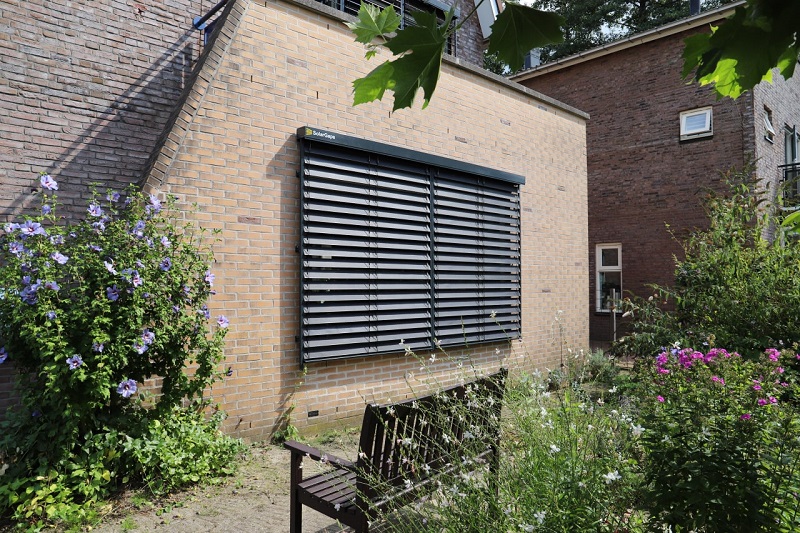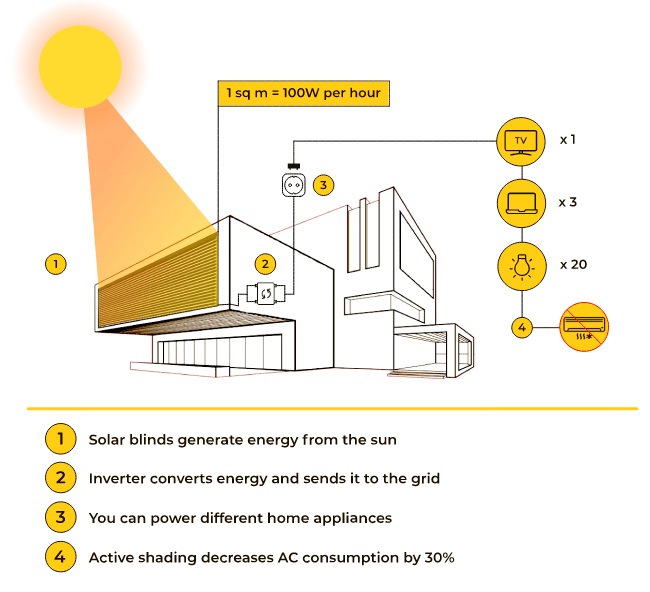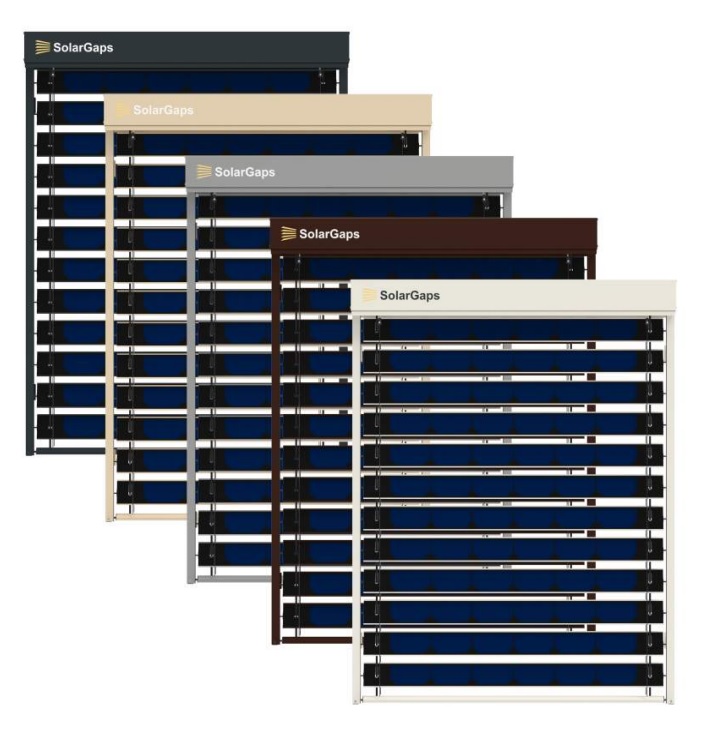Solar powered energy is big business in the United States and across the world, as technology has made it possible to harness free, renewable energy from the sun and convert that energy into electricity to power homes and cars.
Residential rooftop solar panels have demonstrated that power produced by this method, under ideal conditions, can be more than enough for a typical household’s consumption, allowing homeowners to sell back energy to local power grids through a process known as Net Metering.
However, what happens if you do not have ownership of the roof-top, as in a condominium or apartment situation or live in a dense urban area that prohibits rooftop solar panels?
How can you take advantage of this proven technology that had previously only been available to homeowners with their own rooftops or vast stretches of available land?
Inspired by nature, Ukrainian inventor Yevgen Erik, created Smart Solar Panel Blinds, which track the movement of the sun while harnessing solar energy to create useable electricity for your home. Custom made to fit a window rather than a rooftop, these blinds are the latest technology trend that capitalizes on sustainable technology by blocking heat into your home, while simultaneously producing electricity!
Table of Contents
- What are Smart Solar Panel Blinds?
- How Do Smart Solar Panel Blinds Work
- Best Application for Smart Solar Panel Blinds
- Pricing and Specifications for Smart Solar Panel Blinds
- Additional SolarGaps Resources
Also see:
- Want Solar Panels? Here’s What You Need to Know About NEM
- What to Consider Before Purchasing a Solar Panel System for Your Home
- Need a New Roof? Why You Should Give Solar Shingles a Chance!
- When Can You Expect Your Solar Panel Investment to Break Even?
- Solar Panel Resource for Homeowners
- More Recommended Energy Efficiency Articles
- Related Topics: Solar Energy | Cost Savings | Energy Efficiency | Sustainability | Green Solutions | Taxes | Utilities
What are Smart Solar Blinds?
Smart Solar Blinds, or more specifically solar panel blinds, are solar panels which are cut to resemble louvered window sunscreen blinds. Simply put, if you married a solar panel with a window blind, you would get the concept of a smart solar blind.
These smart blinds are custom made to fit a window and are mounted either on the interior or exterior of a window’s frame, thereby reducing costs and space usage compared to rooftop solar panels.
However, SolarGaps prefers that customers mount their blinds on the exterior of a window, as solar panels should be exposed to full direct sunlight. The exterior mounting also serves an additional benefit of providing external shading and preventing excessive solar heat gain inside.

Image courtesy of SolarGaps.
The smart technology that is built into these blinds, not only allows them to block ultraviolet or UV rays from entering the home, but it also allows the blinds to be controlled from a mobile phone, tablet or other connected device.
The automated rotation feature of Smart Solar Blinds takes a page from nature’s playbook, as solar blinds track the movement of the sun, in the same manner as sunflowers pivot their direction in the sun’s path. This innovative approach allows the panels to soak up enough rays to power up devices connected to the system longer throughout the day.

One of the major players in the smart solar blind industry is SolarGaps, a San Francisco-based technology company started by Yevgen Erik, a Ukrainian-born computer scientist, who developed the prototype for the company’s latest commercially available products.
Erik states that SolarGaps blinds can reduce energy costs by 70% by blocking heat energy from the sun, while producing electricity from those same solar rays.
How Do Smart Solar Blinds Work
Similar to rooftop solar panels, smart solar blinds convert light from the sun into useable electricity with the use of photovoltaic cells embedded on the blind’s panels. However, SolarGaps blinds have a two-pronged approach to reducing your home’s electricity needs:
- They produce energy from the sun that is converted to electricity, and
- They provide shade, similar to traditional sun shades
The concept is quite simple:
Step 1:
SolarGaps smart blinds are mounted on either the interior or exterior of a window frame’s casing to capture solar UV rays, while tracking the sun’s movements. Since SolarGaps perform best in direct sun, it is important to choose those windows that are in the path of the sun’s direct rays for a period of time throughout the day to allow the tracking feature to maximize the sun’s potential.
The tracking features allows the blind to capture as much sunlight as possible in a given day for the mounting area. In the process of capturing the sun’s solar rays, the blinds can also close to prevent rays from heating up the home’s interior, thus creating a dual effect for summertime cooling.
Step 2:
The captured solar energy is converted to electricity with the aid of an inverter that sits on the inside of the window, which sends the electricity to the home’s connected power grid.
Step 3:
With the system’s “Plug and Play” technology, you can immediately connect your appliances and electronic devices into a power outlet. thereby enjoying your free, sustainable, renewable electricity.
SolarGaps smart blinds produce 100 Watts per hour (100Wh) per 1 square meter of window panels. Simultaneously, the blinds operate similar to traditional window sunshades by providing active shading of the sun’s rays into your home, thereby decreasing the need for air conditioning consumption by 30%.
The blinds are most productive during sunny conditions, due to their monocrystalline solar cells, however there will be some level of power generation even during cloudy days.
When not in use, SolarGaps blinds can be fully retracted in a housing or niche, so as not to obstruct your window’s view when solar power generation is not needed.

Diagram courtesy of SolarGaps.
Solar Blinds that Generate Electricity | The Henry Ford’s Innovation Nation
Best Application for Smart Solar Blinds
A substantial market exists for SolarGaps Blinds for those not able to take advantage of current solar rooftop panels due to costs and space constraints. High density urban areas that would certainly benefit from auto-production of electricity have been a target of the company, especially in Europe and other densely populated large cities.
Condominiums are another promising market, especially when establishing sufficient buy-in from one’s Homeowners Association, which could also lead to receiving volume discount pricing.
The distance between the sections of SolarGap dressed windows can be as close as 5 to 10 mm (.197 to .394 inches).
Pricing and Specifications for Smart Solar Blinds
SolarGaps Smart Blinds are available in five colors to contrast with your existing internal or external color palette:
- White
- Grey Metallic
- Beige
- Brown
- Anthracite


Colors Left to Right: Anthracite, Beige, Grey Metallic, Brown, White
Pricing is based on the size of the window you wish to cover. Once you have accurate measurements of your windows, visit the SolarGaps website to generate a price quote for window covers only. Inverter pricing is not included in this quote process.
Unfortunately, additional items such as the inverter are sold separately, since the company’s products will work with any commercially available inverter. Thus, if you are transitioning from one solar product to SolarGaps, you can reuse your existing inverter with their products.
The blinds are backed by a 2-year warranty, which is standard in the solar industry.
Current Availability
Currently SolarGaps holds all necessary certifications for the European Market to allow them to sell and implement their products freely in the EU.
Even though SolarGaps’ products currently meet meet US electronics requirements, SolarGaps is still in the process of obtaining product certifications for US sales and installations in Q4 2022.
Additional SolarGaps Resources
- SolarGaps Website
- SolarGaps FAQs
- SolarGaps Price Quote Form
- SolarGaps Photo Gallery
- SolarGaps Blog
- SolarGaps YouTube Channel
- SolarGaps Distributors
Recommended Energy Efficiency for the Home Reading
- Green Mortgages: An Eco-Friendly Way to Combat Rising Interest Rates
- 7 Tips on How to Make Your Home Up-to-Date & On-Trend
- The New American Home 2022: A Courtyard Design for a Narrow Lot
- The New American Remodel 2022: A Mid-Century “Modernized” Preservation
- Building Technologies for Disaster Resistant Homes
- The New American Remodel 2021: Sustainable & Energy Efficient Beauty
- 10 Exceptional Products in The New American Home 2021
| Purgula is reader-supported. When you click on links to other sites from our website, we may earn affiliate commissions, at no cost to you. If you find our content to be helpful, this is an easy way for you to support our mission. Thanks! Learn more. |








Super useful and also well described. Many thanks.